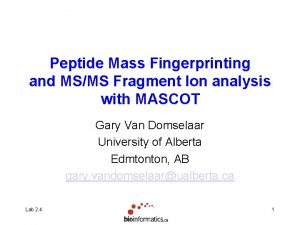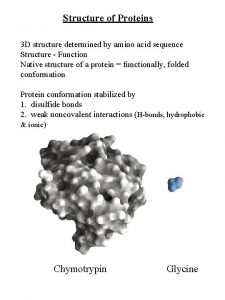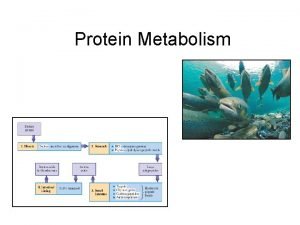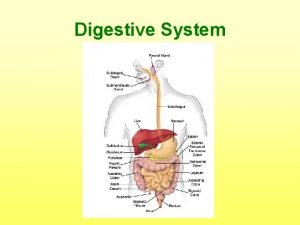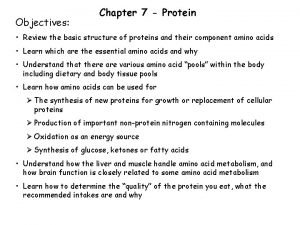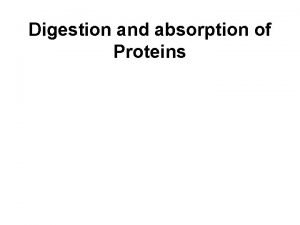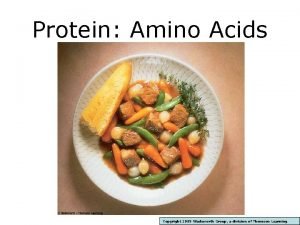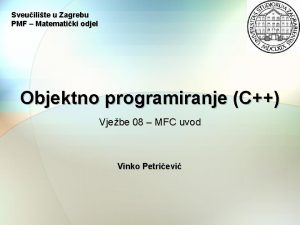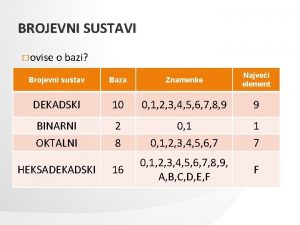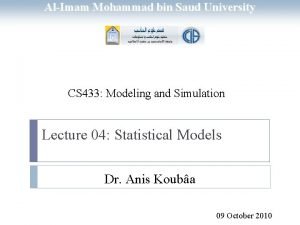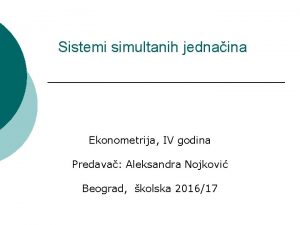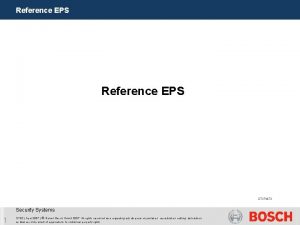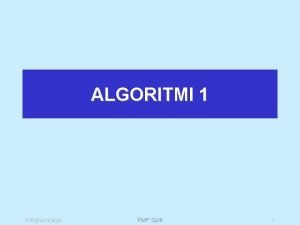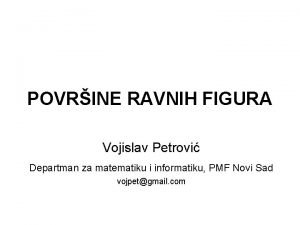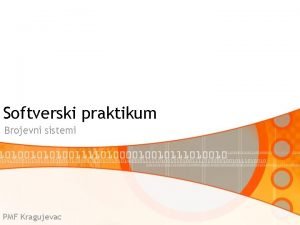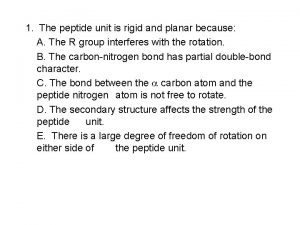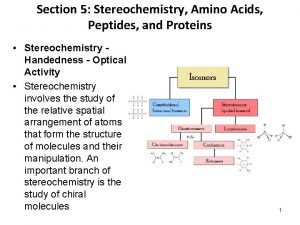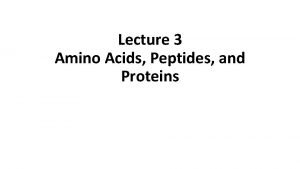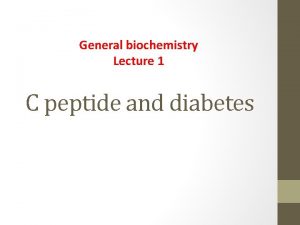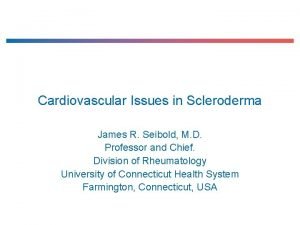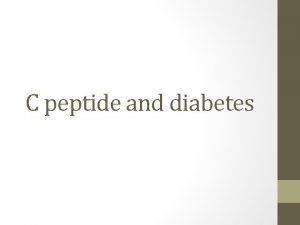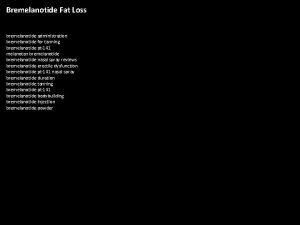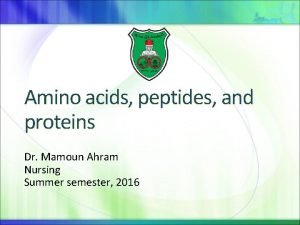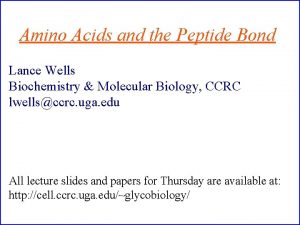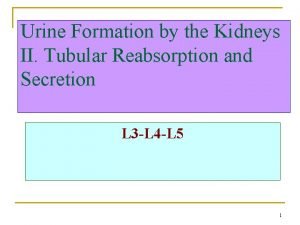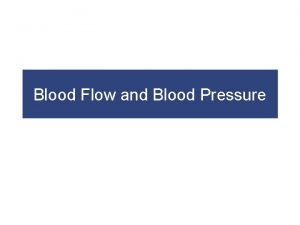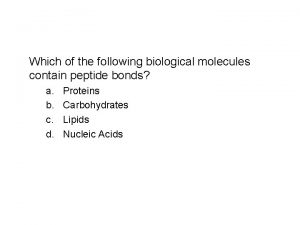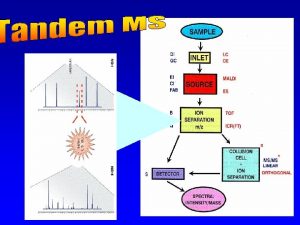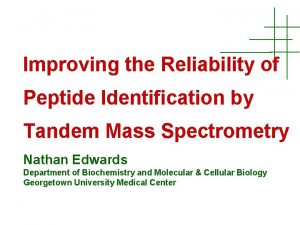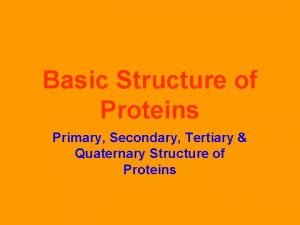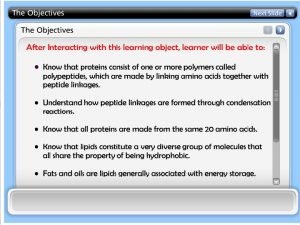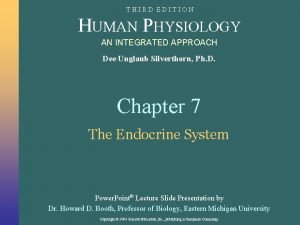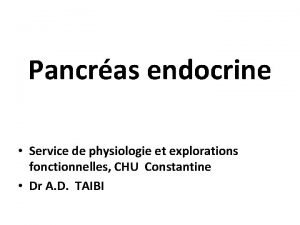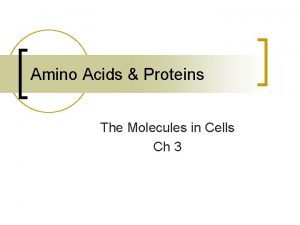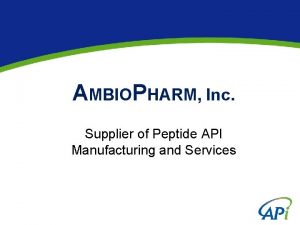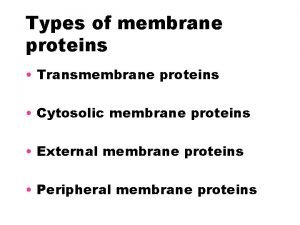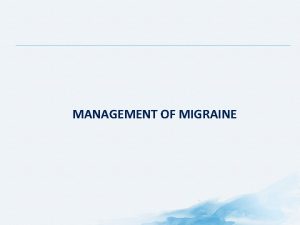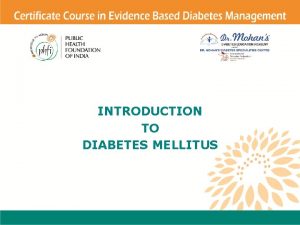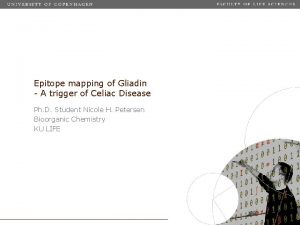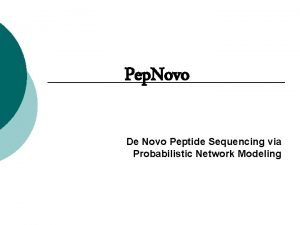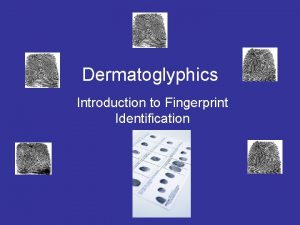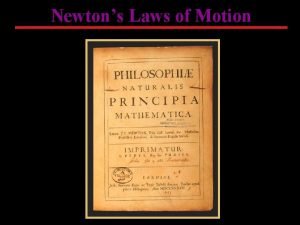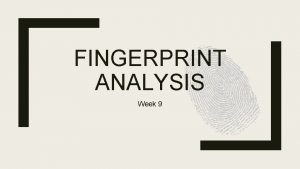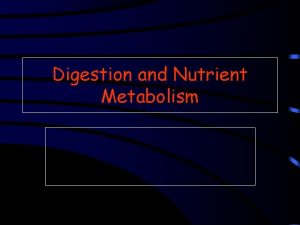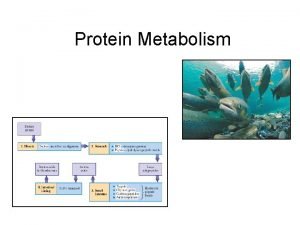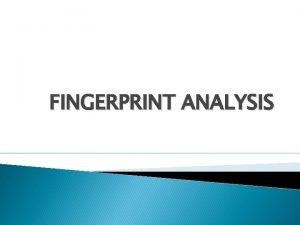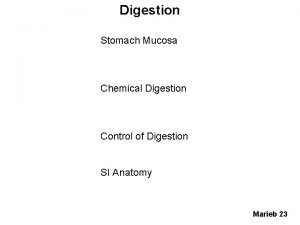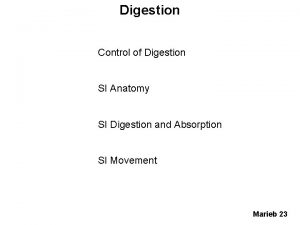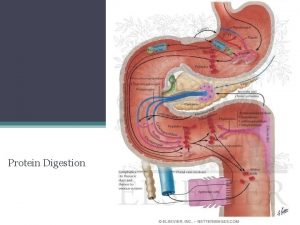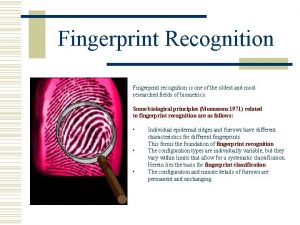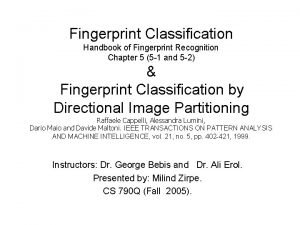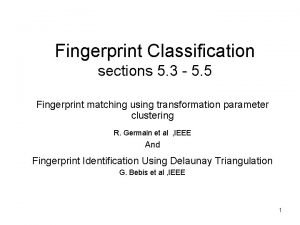Protein digestion and peptide mass fingerprint PMF analysis




























































- Slides: 60

Protein digestion and peptide mass fingerprint (PMF) analysis Yuanming Luo Institute of Microbiology, CAS

Protein digestion ØIn gel digestion ØOn-membrane digestion ØIn solution digestion

Two main approaches for digesting gel-separated proteins Ø Protein blotting onto immobilizing membranes followed by on-membrane digestion (simpson et al. , 1989; Gevaert and Vandekerckhove 2000) Ø Digesting proteins directly in the gel matrix and extracting the peptides (Ward et al. , 1990)

Note: Ø The overall recoveries of peptides from in-gel digestion methods are significantly greater than that from on-membrane digestion strategies. Ø In-gel digestion might fail when the visualized protein is below~10 mg of protein/cm 2 (need a further concentration of weakly stained CBB gel spots (membrane spots) with electrophoresis in a new gel).

In gel digestion Ø 1. Excise the protein gel spots of interest and place in microfuge tube. Ø 2. Remove excess CBB by washing twice with 1 ml of either 0. 1 M NH 4 HCO 3, 50% acetonitrile. Ø 3. Dry each gel piece completely by speed Vac. The gel piece should not stick to the walls of the EP tube when completely dry.

In gel digestion (continued) Ø 4. Rehydrate the gel piece by adding 10 ul of digestion buffer, containing 0. 5 ug of the appropriate protease, directly onto the dried gel piece. Ø 5. Store the gel pieces at 4℃ for over 45 min until the solution has been absorbed Ø 6. If necessary, repeat above two steps to allow the gel pieces to fully swell.

In gel digestion (continued) Ø 7. Add 20 ul of digestion buffer without protease to fully immerse the gel piece. Ø 8. Incubate for 12 -16 hours at 37 ℃. Ø 9. Carefully remove the digestion buffer (now called the extract), and place it into a clean microfuge tube. The digestion buffer contains > 80% of the extractable peptides Ø 10. Add 200 ul of 5 %TFA/50% acetonitrile to the gel piece.

In gel digestion (continued) Ø 11. Incubate the tube with the gel piece for 1 hour at room temparature(37 ℃). Ø 12. Carefully remove the extract away from the gel piece and combine it with previous extract from step 9. Ø Repeat step 10, 11, 12 once again. Ø Concentrate the pooled extracts by speed Vac. Store the peptide extracts at -20 ℃ for future mass spectrometric analysis.

In gel digestion of silverstained gels Ø Most of the steps of in gel digestion for silver-stained gels are the same except for the destaining solution which was prepared by mixing 30 m. M potassium ferricyanide with 100 m. M sodium thiosulfate (1: 1 v/v).

On-membrane proteolytic digestion of electroblotted proteins Ø Proposed membranes are nitrocellulose membranes, because the hydrophobic surface of PVDF limits the recovery of peptide fragments. Ø Proposed dyes are Amido Black and Ponceau S, which are compatible with proteolytic digestion, peptide extraction from membrane and subsequent RP-HPLC analysis of peptides.

Electroblotting of staining the protein Ø 1. electroblot the proteins from the gel onto a nitrocellulose (for proteins that are difficult to transfer, add up to 0. 005% SDS) Ø 2. stain the membrane with either Amido Black or Ponceau S. Ø E. g. , for staining with Amido Black Ø A. immerse the nitrocellulose membrane in 0. 1% Amido Black 10 B for 1 -3 minutes Ø B. Rapidly destain with several washes of

Electroblotting of staining the protein (continued) Ø C. Rinse the destained blots thoroughly with deionized H 2 O to remove any excess acetic acid. Ø D. cut out the stained protein band (or for 2 D gel spots, up to 40 spots from identical gels may be required) and transfer these bands to 1. 5 -ml microfuge tubes for immediate processing (begin with step 3) or for storage at -20℃.

For staining with Ponceau S Ø A. Immerse the nitrocellulose membrane in 0. 1% Ponceau S for 1 minute. Ø B. Gently agitate the blot for 1 -3 min in 1% acetic acid to remove excess stain. Ø C. Cut out the protein bands of interest and transfer them to microfuge tubes. Ø D. Destain the protein bands by washing the membrane pieces with 200 m. M Na. OH for 1 -2 min. Ø E. Wash the membrane pieces with deionized H 2 O and process them immediately or store them wet at -20℃(avoid excessive drying).

Digestion of the membrane-bound proteins Ø 3. Add 1. 2 ml of 0. 5% (w/v) PVP-40 (which is used to prevent absorption of the protease to the nitrocellulose during digestion) in 100 m. M acetic acid to each tube. Ø 4. Incubate the tube for 30 min at 37 ℃. Ø 5. Centrifuge the tube at ~1000 g for 5 min. Ø 6. Remove the supernatant solution

§ 7. Add ~1 ml of H 2 O to the tube. (It is essential to remove excess PVP-40 before peptide mapping because of the strong UV absorbance of this detergent. Moreover, breakdown products of PVP-40 produce major contaminant peaks in ESI-MS) § § 8. Votex the tube for 5 seconds. 9. repeat step 5 and 6. 10. repeat steps 7 -9 five more times. 11. cut the nitrocellulose strips into small pieces (~1 x 1 mm) and place them in a fresh tube (0. 5 - or a 0. 2 ml tube).

Digestion of the membrane-bound protein (continued) § 12. Add the minimal quantity of digestion buffer (10 -20 ml) to submerge the nitrocellulose pieces. § 13. After digestion, tryptically 16 hours or overnight at 37 ℃, load the total reaction mixture onto an appropriate RP-HPLC column for peptide fractionation (or store the peptide mixture at -20 ℃ until use).

In soltion digestion

Mass spectrometry involved in proteomics Ø Matrix-associated laser desorption ionization time of flight mass spectrometry (MALDI-TOFMS) Ø Electrospray ionization (ESI) ion trap mass spetrometry Ø Surface-enhanced laser desorption ionization (SELDI) time of flight mass spetrometry

Linear and reflectron MALDI-TOFMS Ø Linear MALDI-TOF-MS (lower accuracy) Ø Reflectron MALDI-TOF-MS: (1) higher accuracy, (2) Post-source decay (PSD), (3) delayed extraction

Mass spectrometry terms Ø Mass to charge (m/Z): Mass spectrometers measure the mass-tocharge values of molecular ions. Ø Resolution: resolution can be defined as the ability to separate and measure the masses of ions of similar, but not identical, molecular mass. Ø Signal to noise: Ø Monoisotopic mass versus average mass:

What is the difference between monoisotopic and average peptide mass? Ø As shown in the table, below the atoms that make up the naturally occurring amino acids found in proteins are not isotopically pure. Natural Abundance of Isotopes Commonly Found in Proteins Atom Most Abundant Isotope Next Most Abundant Isotope Carbon 12 C 98. 9% 13 C 1. 11% Nitrogen 14 N 99. 6% 15 N 0. 366% Oxygen 16 O 99. 8% 18 O 0. 204% Sulfur 32 S 95. 0% 34 S 4. 22%

Deisotoped MALDI spectrum

n MS Interpreting of the spectra of peptides (AGFI)

Singly-charged peptide fragmentation

Reaction products: Proton on carbonyl (case 1)

Reaction products: Proton on amine (case 2)

Doubly-charged peptide fragmentation

Reaction products: Proton on carbonyl (case 1)

Reaction products: Proton on amine (case 2)

Where is the b 1 ion? Why is the a 2/b 2 big?

Peptide mass fingerprint (PMF) analysis by MALDI-TOF -MS

MALDI difficulties Ø Salts and other contaminants Ø Selection of matrix Ø Sample itself Ø Crystallization Ø Calibration (external or internal cablibration) Ø Accuracy (ppm) Ø Resolution Ø Amount of protease

Ø Dissolve the peptide mixture in 0. 1%TFA. Ø Desalt by Zip. Tip C 18 microcolumn (optional). Ø Directly elute the peptide mixture with -cyano-4 -hydroxy cinnamic acid (CHCA) in 70% acetonitrile and spot the peptide mixture on sample plate. Ø The peptide mixtures cocrystallize with matrix on sample plate

Ø Input of instrumental method and parameter setup Ø Calibration of spectrometer by external calibration Ø Crude spectrum Ø Tuning of parameters Ø Internal calibration of PMF spectra Ø Data processing for database search

Peptide and protein standards § Angiotensin II (human) MW: 1046. 2 Substance P (human) MW: 1347. 7 Insulin (bovine) MW: 5733. 6 Cytochrom c (equine) MW:

Manually spot samples onto sample plate


Recrystallization methods for MALDI matrices Ø Method 1: Ø Re-crystallization in 70% Me. CN/30% water. 1. Heat a saturated solution of the matrix in 70% Me. CN/30% water until boiling. 2. Carefully boil until solid dissolves completely. 3. Cool to room temp, then on ice precipitate should form. 4. Filter precipitate.

Recrystallization methods for MALDI matrices Ø Method 2: Ø Protocol for re-crystallization of alphacyano-4 -hyrdoxy-cinnamic acid 1. To 100 mg of alpha-cyano-4 -hydroxycinnamic acid, add 10 ml of water 2. Add ammonium hydroxide until most of acid dissolves. 3. Slowly add concentrated HCl to the solution until a large amount of the acid has precipitated (about p. H 2). 4. Remove the precipitate by centrifugation or filtering. 5. Wash the precipitate several times with 0. 1 M HCl.

Calibration Used for calibration


It would be extremely difficult to measure a monoisotopic mass for BSA. In practice, most instruments report monoisotopic molecular weights up to a certain cutoff point. Above this cut-off, isotopic envelopes are centroided as a whole to provide average mass values.

Control the sample plate CHCA

Parameters setup of PMF Ø Instrument:Voyager DETM PRO Biospectrometry. TM workstation, Ø Parameters: matrix: α-Cyano-4 hydroxycinnamic acid(CHCA) (1)delayed extraction, 150 ns、 (2)reflector mode、(3)positive; (3)acceleration voltage: 20000 V; (4)Grid voltage 75%;(5)Guide wire: 0. 02%;(5)mass range: 800 -3500 Da。

PMF containing isotope peaks

monoisotope spectrum

PMF spectrum of annexin I

Mass list of annexin I (monoisotope) Ø 855. 433556 Ø 908. 444342 Ø 912. 518921 Ø 936. 511625 Ø 966. 487904 Ø 982. 482524 Ø 1011. 539929 Ø 1064. 543038 Ø 1092. 608231 Ø 1213. 550297 Ø 1262. 595173 Ø 1523. 808451 Ø 1543. 863778 Ø 1640. 800435 Ø 1649. 789297 Ø 1651. 894876 Ø 1724. 838185 Ø Ø Ø Ø 1746. 906727 1768. 874981 1803. 789401 1807. 994050 1815. 963445 1816. 950528 1820. 832451 1903. 003019 1944. 068873 1945. 050987 2132. 706314 2148. 959052 2163. 051584 2203. 054533 2344. 153915 2722. 314675


Database search by MASCOT






Key points for PMF Ø Sample preparation Ø Matrix selection and ratio of sample to matrix Ø Keep the matrix dry Ø Sample properties Ø Internal calibration Ø Database selection Ø Mass accuracy (ppm) Ø Resolution (FWHM) and S/N when tuning

Practical consideration Ø -The final molar ratio sample/matrix is about or around 1/5000. Ø -Final concentration of the sample is from 1 to 10 pmol/ul Ø -Our experience with MALDI point to a dynamic range of 100 fmol/ul to few hundreds pmol/ul Ø -MALDI is relatively robust ionization technique that tolerates the use of salts and surfactants and buffers. Although it is best to remove them for better performance.

Theoretical digestion for PTM identification analysis


Application of MALDI-TOF-MS Ø Molecular weight determination Ø Peptide mass fingerprint Ø Disulfide bond identification Ø C-terminus sequencing
 Mascot peptide mass fingerprint
Mascot peptide mass fingerprint Fibroin secondary structure
Fibroin secondary structure Saltine cracker digestion lab
Saltine cracker digestion lab Protein metabolism notes
Protein metabolism notes Another name for small intestine
Another name for small intestine Digestion of protein by pepsin
Digestion of protein by pepsin Pepsin is
Pepsin is Where is protein digested
Where is protein digested Pmf programiranje
Pmf programiranje Baza brojevnog sustava
Baza brojevnog sustava Pmf of geometric distribution
Pmf of geometric distribution Ekonometrija pmf
Ekonometrija pmf Pmf geografija
Pmf geografija Bu pmf
Bu pmf Fungsi distribusi variabel random diskrit
Fungsi distribusi variabel random diskrit Algoritam programiranje
Algoritam programiranje Pmf
Pmf Pralelogram
Pralelogram Mimoza ristova
Mimoza ristova Tijana prodanovic pmf
Tijana prodanovic pmf Pmf sarajevo
Pmf sarajevo Hornerova sema
Hornerova sema Anthem provider maintenance form
Anthem provider maintenance form Channel vs carrier proteins
Channel vs carrier proteins Protein-protein docking
Protein-protein docking Peptide bond rigid and planar
Peptide bond rigid and planar What is protien
What is protien Milady chemical texture services test
Milady chemical texture services test Peptide synthesis
Peptide synthesis Elevated c peptide
Elevated c peptide Pulmonary hypertension differential diagnosis
Pulmonary hypertension differential diagnosis C peptide interpretation
C peptide interpretation Bremelanotide spray
Bremelanotide spray Importance of peptide bond
Importance of peptide bond Number of peptide bonds
Number of peptide bonds Atrial natriuretic peptide
Atrial natriuretic peptide Cardiac distension
Cardiac distension What biological molecules contain peptide bonds
What biological molecules contain peptide bonds Peptide identification
Peptide identification Peptide identification
Peptide identification Primary secondary tertiary quaternary
Primary secondary tertiary quaternary Peptide bond
Peptide bond Peptide hormone receptors
Peptide hormone receptors Peptide
Peptide Peptide c prise de sang
Peptide c prise de sang Peptide bond dehydration synthesis
Peptide bond dehydration synthesis Ambio pharm
Ambio pharm Peptide chains
Peptide chains Osteopern
Osteopern C peptide interpretation
C peptide interpretation Solid phase peptide synthesis
Solid phase peptide synthesis De novo peptide
De novo peptide Relative atomic mass of beryllium
Relative atomic mass of beryllium Difference between atomic number and atomic mass
Difference between atomic number and atomic mass Atomic mass of oxygen
Atomic mass of oxygen Oxygen electrons per shell
Oxygen electrons per shell Suatu sampel senyawa ionik seberat 0 5662
Suatu sampel senyawa ionik seberat 0 5662 Dermatoglyphics fingerprint analysis
Dermatoglyphics fingerprint analysis Ideal stoichiometric calculations
Ideal stoichiometric calculations Percentage composition of propane
Percentage composition of propane Inertial mass vs gravitational mass
Inertial mass vs gravitational mass
